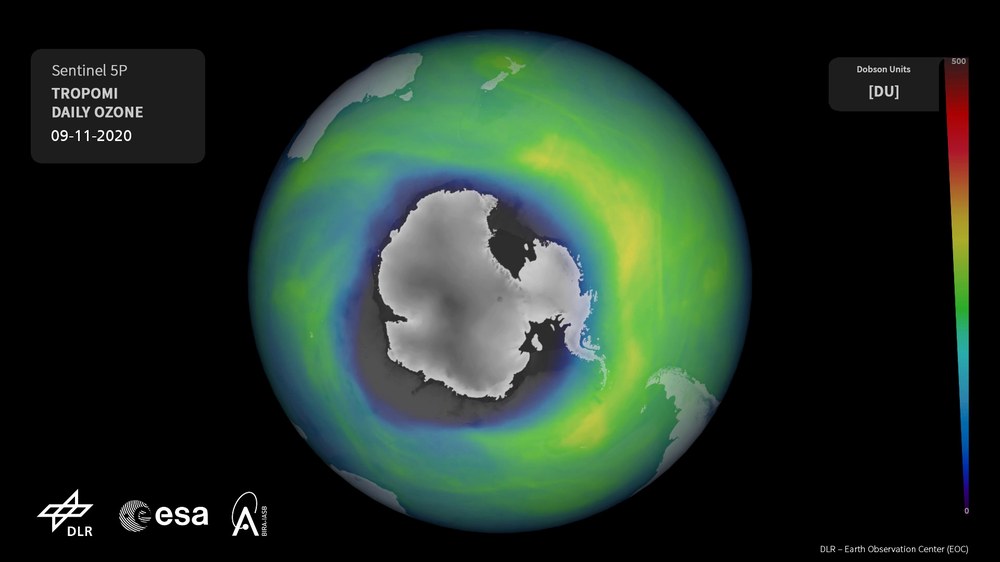Ozone Hole 2020 - especially stable and distinct
The ozone hole over the southern hemisphere is the largest ever recorded and it is still there, although it is meanwhile December.
Chemical processes and the strength of the polar vortex determine the prominence of the ozone hole. This vortex can be imagined as a large low-pressure zone above the pole, extending from the troposphere up into the stratosphere (from the ground up to an altitude of 50 km). The cold polar night of winter in the southern hemisphere gives rise to a strong west wind, prompted by large pressure differences between the polar region and its surroundings, as well as by the Coriolis force. This wind forms the outer edge of the polar vortex and hinders to a large extent the exchange of air masses between the equator and the pole.
As the sun slowly rises In springtime in the southern hemisphere, the process of ozone destruction is initiated in the cold polar vortex. Solar radiation increases as the year progresses, which leads to a considerable energy influx into the atmosphere. The compensating flow between the formerly cold pole and the warm equator decreases because the temperature in the stratosphere at the pole continues to rise. During summer in the southern hemisphere an east wind automatically arises in the stratosphere as a compensating flow between the pole and the equator.

Ozone Hole 2020
Your consent to the storage of data ('cookies') is required for the playback of this video on Quickchannel.com. You can view and change your current data storage settings at any time under privacy.
This year the transition from a west wind to an east wind system has not yet taken place. The cause might be the unusually strong development of the polar vortex in the southern hemisphere during this year’s winter and spring in the southern hemisphere
The polar vortex is usually modulated by the influence of planetary waves, which disrupt the west wind by diverting air masses to the north and south along a belt of strong wind. The stronger the modulation the weaker the polar vortex. This year planetary wave activity was especially low.
The figure shows in black the evolution of planetary wave activity for 2020 at some 30 km altitude. It is evident that starting in September the activity especially of planetary wave 1, but also of wave 3 is below average. The range of variation of this activity is also less than normal. That means that the polar vortex has remained in its circle form over the pole since September. The activity of all three planetary waves had strongly increased at the end of the period (5 December). This suggests the collapse of the vortex and a shift to summer conditions in the circulation of the stratosphere.

One cause for the particularly low activity of planetary waves could possibly come from the equatorial Pacific Ocean, where the El Niño Southern Oscillation “ENSO” occurs. It influences not only the entire Pacific region but also global atmosphere dynamics.
ENSO describes a variation in ocean surface temperatures in the tropical Pacific that takes place approximately every three to seven years. Pacific Ocean surface temperatures alternate especially off the Latin American west coast between particularly cold (La Niña) or warm (El Niño). The mechanism is attributed to a coupling of the ocean and the atmosphere.
In El Niño years the polar vortex is more unstable, warmer and more strongly deformed than it is in average years. The introduction of heat into the atmosphere at equatorial latitudes is strong during El Niño events because of the higher ocean surface temperatures. This leads to more planetary wave activity. During La Niña events the introduction of energy is very slight because of the lower than normal ocean surface temperatures in the equatorial Pacific. For that reason planetary wave activity is especially low, so the polar vortex during La Niña events is more stable, colder and more pole-symmetric. There is currently a strong La Niña event underway. It could be that the polar vortex in the southern hemispheric stratosphere was so stable, also because of the La Niña influence, that the formation of the ozone hole was especially favoured. For that reason monitoring the polar vortex is especially interesting at present.
